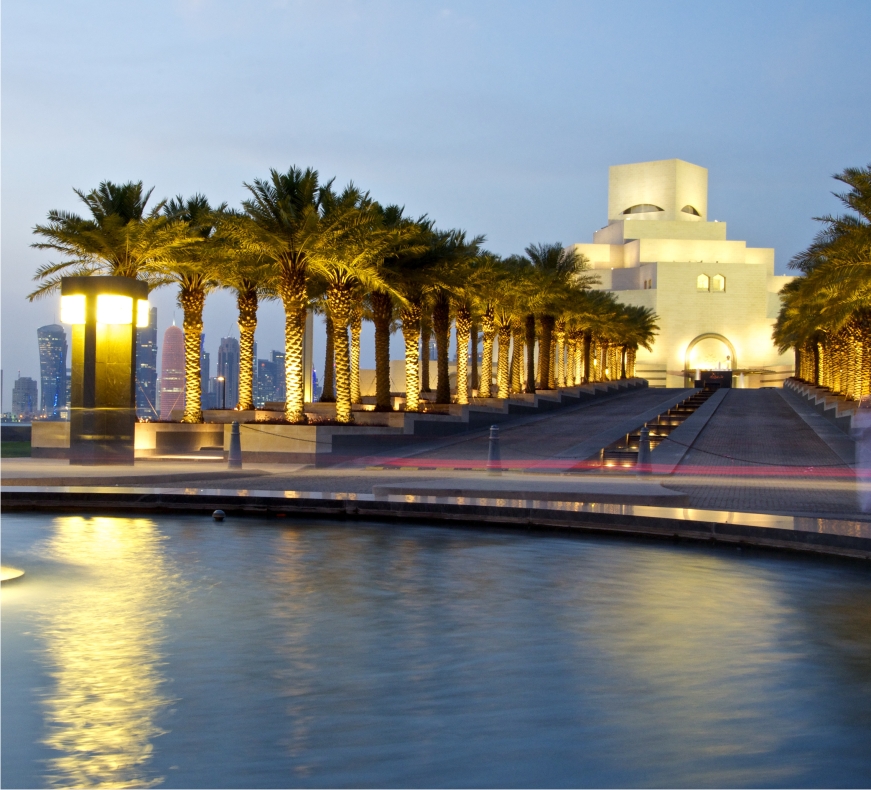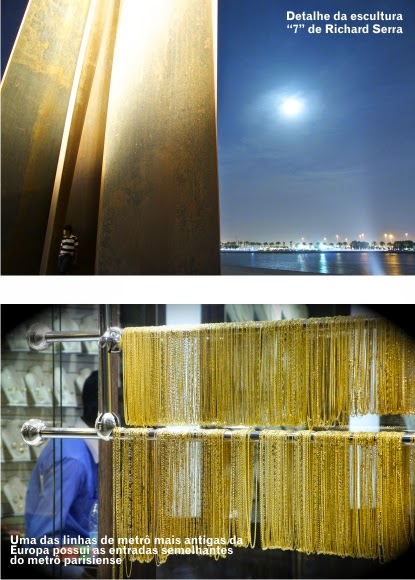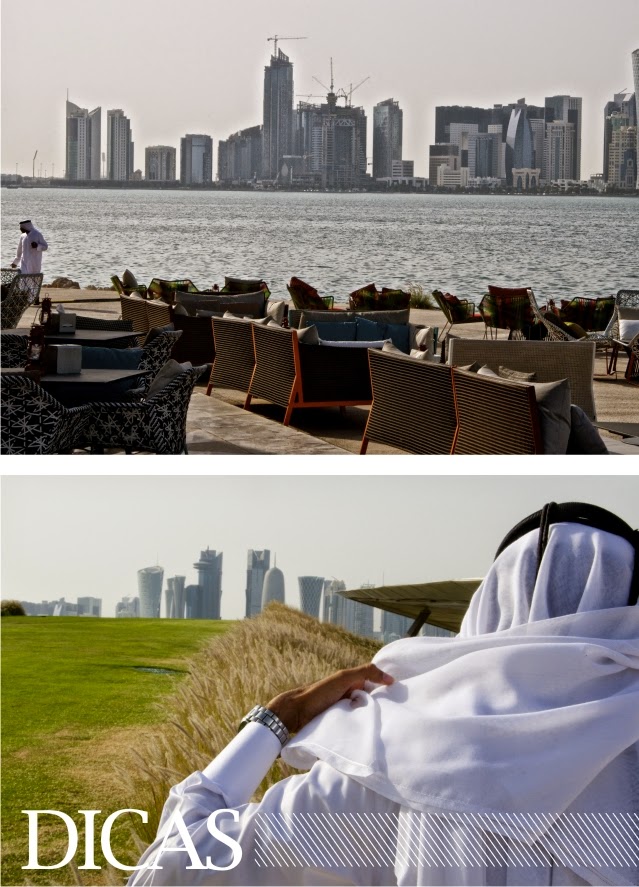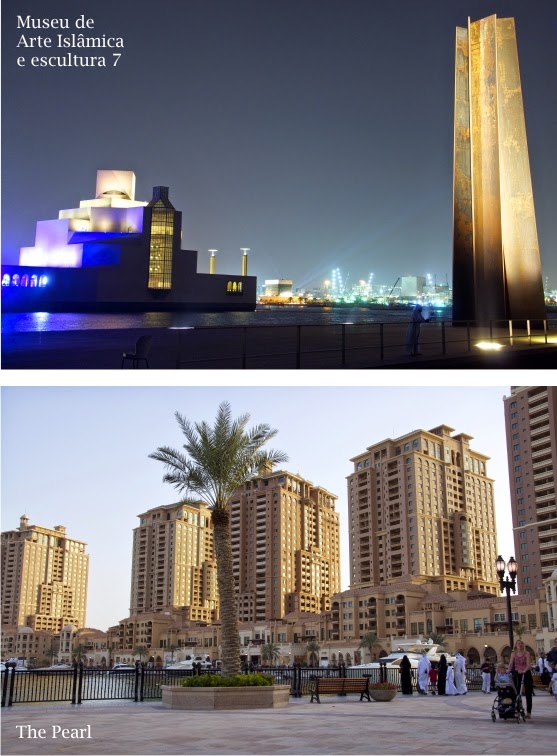
Texto / Fotos Pablo Augusto Relly
Escrever sobre o Catar tem um peso diferente. Apesar de – na sequência – classificar o país como local de passagem, e não um destino turístico final, foi na capital, Doha, que passei meu último ano. O objetivo era aprender árabe (missão sem fim) e cultura islâmica, elementos necessários para quem planeja trabalhar na região como jornalista, e assim, quem sabe, evitar as falácias muito comuns de quem reporta sobre países árabes. Logo, as atrações são mais do que lugares a serem visitados. Elas carregam histórias, perplexidades, lições, certamente muitas risadas, também muita caminhada – achar táxis disponíveis, às vezes, é um pouco complicado. Bem, caminhar é um hábito saudável, e uma boa maneira de explorar um sítio novo.
A área do Catar é cerca de um quarto da área do estado do Rio de Janeiro. O país, localizado em uma península do golfo Pérsico, no Oriente Médio, é geralmente um ponto de conexão de voos, já que é a sede da Qatar Airways. Antes da descoberta do petróleo – e dos campos de gás, a economia era baseada na pesca, e na produção de pérolas. Os petrodólares trouxeram avanço econômico. De um passado relativamente pobre, atualmente o Catar é um dos mais ricos países do mundo, com renda per capita anual na casa dos 220 mil reais. Na paisagem de Doha, que está em constante evolução, estão inúmeros arranha-céus. A península é um enorme canteiro de obras, e recebe (de acordo com o planejado) a Copa do Mundo de 2022.
A população desta nação liderada pelo mais novo líder da região, o emir e xeque Tamim Bin Hamad Al Thani, que completa 34 anos em junho deste ano, é de aproximados dois milhões de habitantes. A maioria deles estrangeiros, já que os locais, catarianos, não passam de 300 mil. Doha concentra a maior parte dos moradores do país – e um trânsito terrível nas horas de pico. Uma boa rede de transporte público (adicione aqui o barulho do vento para refletir a desolação com o tópico transporte público) inexiste, porém, o metrô está em construção.
Writing about Qatar is a complex challenge. Despite my classification of the country as a transit location that is not a final destination for tourists, I have spent the last year in Qatar´s capital city, Doha. My aim was to learn Arabic (an endless mission) and understand Islamic culture, both of which are essential for those who plan to work as a journalist in the region and hope to avoid the increasingly common fallacies associated with foreign reporters in Arabic countries. There are more attractions than places to visit, all of which involve stories, perplexities, lessons, a great many laughs, and long walks – finding available taxis can sometimes be very complicated. Anyway, walking is a healthy habit and is a good way to explore a new place.
Qatar has an area of approximately one quarter of the area of the state of Rio de Janeiro. The country is located on a peninsula of the Persian Gulf in the Middle East and contains the headquarters of Qatar Airways. Hence, it is usually a place for flight connections. Prior to the discovery of petroleum and gas fields, the economy was based on fishing and the production of pearls, but petrodollars brought economic advances. Qatar was once a relatively poor country but is now of the World´s richest, with an annual per capita household income of 220,000 Brazilian Reals. Doha´s skyline is constantly changing and contains numerous skyscrapers. The peninsula is an enormous construction site and Qatar will host (according to current plans) the World Cup in 2022.
The population of approximately two million inhabitants are led by the youngest leader in the region, the Emir and Sheikh Tamim Bin Hamad Al Thani, who will be 34 years old in June of this year. The majority of the population are foreigners. Qataris do not number more than 300,000. Doha contains the bulk of the countries residents and has terrible traffic jams during peak times. There is no efficient public transportation system, although a subway network is currently under construction. (Add here the noise of the wind to reflect on desolation and the public transport system).
ATRAÇÕES EM DOHA
O Souq Waqif foi construído num estilo que lembra os tradicionais mercados árabes. Nele, estão lojas com lembranças típicas, artesanato, especiarias, perfumes e incenso. Produtos naturais como mel, ou cerâmicas podem ser encontrados no Souq Omani, enquanto o Golden Souq, o mercado de ouro, na tradução direta, é o local para comprar joias. As pérolas, geralmente, têm bom preço. O Souq Waqif ainda reúne restaurantes, hotéis boutique, cafés – lotados nas noites dos finais de semana quando músicos regionais tocam ao vivo. A plateia é dividida em espaços para famílias e para homens solteiros. Vale a pena dar uma olhada no calendário do Souq Waqif, pois há diversos festivais durante o ano. Em um deles, a desconhecida no Brasil, mas estrela no Oriente Médio, a cantora libanesa Nancy Ajram levou uma multidão ao Souq, no início de 2014.
Perto do Souq Waqif, o Museu de Arte Islâmica, que foi aberto ao público em 2008, apresenta coleções permanentes, além de exposições temporárias. O acervo é composto por artefatos que introduzem a arte islâmica – em metal, cerâmicas, joias, trabalhos em madeira, têxteis e em vidro –, coletados em três continentes, e que datam do século sete ao século 19. O museu foi projetado pelo arquiteto chinês I.M. Pei, um prédio majestoso e icônico em Doha. A entrada é gratuita.
Do lado de fora, os jardins do museu são um excelente local para dar uma caminhada no final do dia, relaxar, observar. É onde está localizada a escultura “7”, do famoso escultor norte-americano Richard Serra, de 74 anos. A obra mais alta criada por ele, “7” tem cerca de 24 metros de altura, e, como o nome indica, são sete placas de aço, arranjadas em formato heptagonal. A obra celebra o significado científico e espiritual do número sete na cultura islâmica.
Corniche, o calçadão na beira do mar e com aproximados sete quilômetros de extensão, é uma caminhada obrigatória para quem visita Doha. Quer dizer, não os sete quilômetros, claro. E a melhor hora para visitá-lo também é no final do dia. Com a temperatura mais amena – é importante reiterar, evite os meses mais quentes do ano, do contrário, não existe “temperatura amena” –, casais de diversas nacionalidades aparecem para caminhar, atletas amadores para correr, famílias para conversar. Corniche leva ao centro moderno de Doha, se o ponto de partida foi o Museu de Arte Islâmica. No centro, torres de vidro e aço em arquitetura contemporânea dominam, além de hotéis, e o conhecido shopping “City Center”.
Como o Catar é um país jovem, a independência data de 1971, muitos dos pontos turísticos são construções mais novas como Katara. Katara é uma vila cultural com teatros, salas de concertos, galerias de arte, restaurantes, e cafés. Ainda com algumas partes em construção, a vila oferece programação variada. De festivais internacionais, regionais, performances, shows, e exposições – local geralmente repleto de catarianos –, Katara também entra na lista (ou deveria entrar) de qualquer visitante em Doha. Informações da programação aqui.
ATTRACTIONS IN DOHA
The Souq Waqif was built in the style of traditional Arab markets and it includes stores that sell typical souvenirs, crafts, spices, perfumes and incense. Natural products such as honey or ceramics can be found in the Souq Omani, whereas the Golden Souq (literally, the Golden Market) is the place to buy jewelry. Pearls are generally sold at reasonable prices. The Souq Waqif also contains restaurants, boutique hotels and cafés, which are full on weekend nights when regional musicians play live music. The crowd is divided into a family area and a singles area. It is a good idea to check the calendar of the Souq Waqif for the different festivals it stages throughout the year. In one such festival at the beginning of 2014, Lebanese singer Nancy Ajram (unknown in Brazil but a star in the Middle East) brought huge crowds to the Souq.
Close to the Souq Waqif, the Museum of Islamic Art was opened to the public in 2008. It contains permanent collections and temporary expositions. The collection is composed of artefacts that introduce Islamic art – metal, ceramic, jewels, wood, textiles and glass –, which were gathered from three continents and date from the 7th to the 19th century. The museum was designed by the Chinese architect I.M. Pei and is a majestic and iconic building in Doha. Entry is free.
The museum´s garden is an excellent place to go for a relaxing walk at the end of the day and take it all in. It contains the “7” sculpture by the famous North American artist Richard Serra, who is now 74 years old. The “7” is his tallest piece of art at close to 24 meters in height. As suggested by the name, it is made up of seven steel plates, organized in a heptagonal design. The sculpture celebrates the scientific and spiritual significance of the number seven in Islamic culture.
Corniche, the seaside boardwalk, is approximately seven kilometers long and is a must for any visitor to Doha. You don’t need to walk all seven kilometers of course! The best time to visit the boardwalk is in the early evening when the temperatures are milder. It is important to reiterate that you should avoid the hottest months of the year, when mild temperatures don’t really exist. Couples of many different nationalities can be seen taking a stroll, alongside amateur athletes running and families having a chat. Corniche leads to the modern center of Doha, starting from the Museum of Islamic Art. Downtown is dominated by contemporary towers of steel and glass, as well as hotels and the famous “City Center” shopping mall.
Qatar is still a young country, only gaining independence in 1971, and consequently, many of the sights for tourists are new buildings, like Katara. Katara is a cultural village with theatres, concert halls, art galleries, restaurants and cafés. Although some parts of the village are still under construction, it offers a wide variety of options, including regional and international festivals, performances, shows and expositions. Katara is usually full of local Qataris and is (or should be) a must-see for all visitors to Doha. Information about schedules can be found at katara.net/english/program-tickets.
Na sequência de projetos enormes, criados pelo homem, “The Pearl” é um empreendimento residencial e comercial. Uma ilha artificial, a área recebe apartamentos e casas de luxo, além de restaurantes, hotéis, e uma marina. É o suprassumo do luxo, e onde, além de marcas internacionais como Hermes, Armani, Balenciaga, entre várias outras, dá para comprar carro novo também: Ferrari, Maserati e Rolls-Royce. Se uma Ferrari não entra no orçamento, sem problemas. O passeio pelo “The Pearl” é ao menos gratuito.
Com as principais atividades realizadas em Doha, é hora de escapar ao deserto da península. As possibilidades são diversas, assim como empresas que oferecem excursões com opções de acampamento pela noite, passeios de camelo, e claro, fazer rally pelas dunas. Ao sul da capital, “Sealine” é um destino popular para quem mora no país. É a junção do deserto com o mar – a beleza das praias não é comparável às praias brasileiras –, e uma ótima maneira de encerrar a viagem. Longe das ideias fabulosas e equivocadas que existem sobre as mil e uma noites do mundo árabe, na imensidão do deserto e admirando as estrelas, o Catar pode não ser um destino final de turismo, mas tem autoridade para surpreender.
Also among the enormous projects in Doha, “The Pearl” is a commercial and residential enterprise. It is an artificial island containing luxurious houses, apartments, restaurants, hotels and a marina. The island is the epitome of luxury, where shoppers can buy international brands such as Hermes, Armani and Balenciaga, among others, as well as cars such as Ferrari, Maserati and Rolls-Royce. If a Ferrari is a little out of your price range, don’t worry. A trip to the “The Pearl” is free at least.
The main tourist activities available in Doha involve escapes into the desert of the peninsula. The possibilities are endless, as is the number of companies that offer guided excursions by night, camel rides and of course, the opportunity to rally across the dunes. To the south of the capital, “Sealine” is a popular destination for residents of the country. It is the meeting point of the desert and the sea (the beauty of the beaches pales in comparison to Brazilian beaches) and is a great way to finish a trip. It is a long way from the fabulous, and incorrect, notions of a thousand and one nights in the Arab world. While admiring the stars in the immensity of the desert, one can begin to believe that Qatar, despite not being the final destination for many, still has the capacity to surprise.
– Para quem estiver de passagem pelo Catar, é interessante evitar os meses de extremo calor, de junho até setembro. É o período quando as temperaturas – podem se aproximar dos 50°C – e a umidade impossibilitam qualquer tentativa de manter a elegância ao ar livre.
– Há voos diretos de São Paulo para Doha, pela Qatar Airways.
– Ao passear pelo parque do Museu de Arte Islâmica, há um café, com uma das mais bacanas vistas para o centro de Doha. Parar ali para colocar e leitura em dia na viagem, ou simplesmente relaxar, e testemunhar o por do sol garante boas fotos, quem sabe, boas lembranças. De setembro/outubro até maio, concertos ao vivo de jazz acontecem no mesmo lugar em um palco montado especialmente para as noites de música. Eventos gratuitos, e imperdíveis.
– Do Museu de Arte Islâmica, há um ônibus gratuito que leva ao Mathaf: Museu Árabe de Arte Moderna. Um pouco distante do centro, sediado na Cidade da Educação, uma área com instalações de ensino, de escolas até filiais de universidades do exterior, o museu recebeu “Turbulence” em 2014, de Mona Hatoum. Artista de origem palestina, que já expôs no Museu de Arte Contemporânea de Chicago, no MOMA, ainda o Centro George Pompidou, em Paris, Mona ganhou fama por performances e obras em vídeo que focavam no corpo. Mona Hatoum evoluiu ao longo dos anos 90 para instalações de grande porte. Apesar do ônibus sem custo para o Mathaf: Museu Árabe de Arte Moderna, a entrada nesse museu custa cerca de R$ 15,00.
Outras informações em aqui.
– Sob a tutela da xeque Mayassa bint Hamad bin Khalifa Al Thani, irmã do emir, que preside a Autoridade dos Museus do Catar, o país sedia frequentemente exposições de artistas famosos internacionalmente, como o britânico Damien Hirst, em 2013, Richard Serra, em 2014, entre outros. Conferir a programação dos museus em qm.org.qa/en/content/museums.
– Passar fome em Doha? Sem jeito. Restaurantes libaneses, turcos, indianos, iemenitas (até brasileiro, e a lista segue) são fáceis de encontrar, e na maioria dos casos, comida deliciosa – e para todo tipo de orçamento. O libanês Al Mourjan, em Corniche, na beira do mar, é o terror para quem estiver de dieta, e isso já nas entradas. Porém, a comida é tão bem preparada, que dá para encarar um jogging no dia seguinte em Corniche para queimar as (milhares) de calorias consumidas no Al Mourjan. O preço também acompanha a qualidade, mas vale a pena. No Souq Waqif, em uma ruela paralela à principal, o simples restaurante iemenita “Sanaa”, e bem mais em conta do que o libanês previamente citado, é um achado. Dá para sentar no chão, comer com a mão, e desfrutar da hospitalidade iemenita. Em Katara, o Mamig, de origem armênia, salgado no preço, é outra opção. Mais um restaurante que faz a dieta ir ao espaço. Álcool não é servido em todos os restaurantes.
 – Ao visitar o Catar, leve em consideração que se trata de um país muçulmano, com tendência conservadora. O conservadorismo, em vários casos, é mais uma questão cultural do que religiosa. Atenção ao que se veste. Mesmo em dias mais quentes, é aconselhado usar roupas que cubram mais o corpo, de tecidos leves, ou pelo menos abaixo do joelho. Atenção também para exagerada demonstração de afeto em público. Para ser respeitado, primeiro deve-se respeitar.
– Ao visitar o Catar, leve em consideração que se trata de um país muçulmano, com tendência conservadora. O conservadorismo, em vários casos, é mais uma questão cultural do que religiosa. Atenção ao que se veste. Mesmo em dias mais quentes, é aconselhado usar roupas que cubram mais o corpo, de tecidos leves, ou pelo menos abaixo do joelho. Atenção também para exagerada demonstração de afeto em público. Para ser respeitado, primeiro deve-se respeitar.
– Doha certamente não é destino para baladeiros de plantão. A vida noturna – leia-se danceterias, bares e afins – é mais modesta do que Dubai, por exemplo, e concentra-se em hotéis, como o Intercontinental, ou o W Hotel, La Cigale, entre outros, onde o consumo de álcool é liberado.
COMPRAS
Além do City Center, há outros shoppings na cidade. Aliás, no Golfo, shopping é algo que não pode faltar. O Villagio, projetado em estilo italiano, e com um canal veneziano de 500 metros com gôndolas – sim, brega, breguíssimo – tem pista de patinação no gelo, lojas de “fast fashion” internacionais com preços moderados. Agora, se bateu a vontade de comprar aquela bolsa Prada, Chanel, Gucci, Fendi, Louis Vuitton, um “trench coat” Burberry, roupas da Carolina Herrera, Celine, Dolce & Gabbana e ainda passar na baby Dior, há uma área no shopping chamada Via Domo com as lojas das marcas acima citadas. Não dá para esquecer das joalherias locais, e internacionais, como a Van Cleef & Arpels.
– For those visiting Qatar, it is a good idea to avoid the hottest months (June to September). At this time of year, temperatures can reach 50°C and the humidity makes it impossible to maintain any sort of elegance in the open air.
– Qatar Airways operate direct flights from São Paulo to Doha.
When you visit the park of the Museum of Islamic Art, there is a café with one of the best views of downtown Doha. It’s a good place to stop and read up on your trip or just relax and watch the sunset, which guarantees nice photos and good memories. From September/October to May, live jazz concerts take place on a specially mounted stage. These events are free and unmissable.
There is a free bus that runs from the Museum of Islamic Art to the Mathaf, the Arab Museum of Modern Art, which is a little out of the center in the City of Education. The area contains educational installations, schools and even branches of foreign universities. In 2014, the museum staged “Turbulence”, by Mona Hatoum, a Palestinian artist whose work has been displayed in the Museum of Contemporary Art in Chicago, in the MoMA and in the George Pompidou Center in Paris. Mona became famous for performances and videos that focus on the human body. Her work evolved throughout the 1990´s and began to feature in large expositions. Although the bus to the Mathaf is free, entry to the museum costs approximately R$ 15.00. Further information can be found at mathaf.org.qa/en/exhibitions.
Under the tutelage of Sheikh Mayassa bint Hamad bin Khalifa Al Thani, brother of the Emir, who presides over the Qatar Museums Authority, the country has frequently hosted expositions of internationally renowned artists, including the Briton Damien Hirst, in 2013, and Richard Serra in 2014, among others. Check the schedule of the museums at qm.org.qa/en/content/museums.
You will never go hungry in Doha! Lebanese, Turkish, Indian, Yemeni and even Brazilian restaurants are easy to find and in most cases, delicious food is available in all price ranges. The Lebanese restaurant Al Mourjan by the sea in Corniche is torture for those who are on a diet, and that is just the starters! However, the food in Al Mourjan is so well-prepared that you should simply enjoy it and then go for a jog in Corniche the next day to burn off the (thousands) of calories consumed. The price is in line with the quality, but it is definitely worth it. In the Souq Waqif, on a side street parallel to the main street, the simple Yemeni restaurant “Sanaa” is a lot less expensive than Al Mourjan and is also worth a visit. You can eat with your hands while sitting on the ground and enjoying Yemeni hospitality. In Katara, the Armenian restaurant Mamig is another more luxurious option that will ruin your diet. Alcohol is not served in all restaurants.
– Before visiting Qatar, bear in mind that it is a conservative Muslim country. The conservatism is often more of a cultural question than a religious one. Take care when choosing your clothes. Even on the hottest days, it is recommended to wear light clothes that cover most of the body and go down to your knees at least. It is also advisable to be careful with public displays of affection. If you want to be respected you have to first respect yourself.
– Doha is definitely not a place for party animals. The nightlife (bars, nightclubs, etc.) is more modest than that found in Dubai and is concentrated in hotels such as the Intercontinental, the W Hotel and La Cigale, among others, where alcohol consumption is tolerated.
Shopping
There are shopping malls outside the City Center. In fact, there is no shortage of shopping malls throughout the Gulf. The Villagio was designed in Italian style, with a 500-meter long Venetian canal and gondolas – yes, extremely tacky! It also boasts an ice-rink and international “fast fashion” stores with moderate prices. If you are interested in Prada, Chanel, Gucci, Fendi or Louis Vuitton bags, Burberry coats or clothes designed by Carolina Herrera, Celine or Dolce & Gabbana, not to mention a visit to Baby Dior, a section of the mall called Via Domo has everything you need, including all of the above mentioned stores. One cannot forget local jewelers and their international counterparts, such as Van Cleef & Arpels.









